Smashed!
Although the shell of St Pancras had been saved, the interior was in a rather sorry state. It had been deteriorating for some time, and would continue to do so for several decades.
An effective indicator of this decaying state could be found in the form of the station’s grand clock.
Perched high over the station’s entrance and facing the platforms, the mighty clock- which was 18ft in diameter- had informed generations of travellers of the all-important time, as they hurried to and from their trains.
The clock had been crafted by ‘Dent of London‘ ; major purveyor of luxury timepieces whose craftsmen had also provided the faces for Parliament’s clock tower (aka Big Ben), as well as equipment for Charles Darwin and David Livingstone.
By the late 1970s, the clock was peering out over a dark, smelly station; the once grand timekeeper now nothing more than a magnet for cobwebs, pigeons and bird muck.
In 1978 and in need of cash, wheeler-dealers at British Rail agreed to flog the St Pancras clock to an American collector.
The sum paid was huge- £250,000… so it must have been quite shock when, in the process of taking the clock down, the workmen fumbled their task… and dropped the valuable timepiece!
The clock plummeted to the ground, smashed to smithereens and lost its high price tag in a nanosecond-an expensive catastrophe which bears quite a similarity to one of the most famous scenes from the legendary comedy, Only Fools and Horses!….
In their shattered state, the clock pieces were now deemed to be worth only £25… and a new buyer came forward- Roland Hoggard, a train driver who was shortly due to retire.
After transporting the jigsawed clock back to his home in Nottinghamshire (a task which took over a week), Roland managed to painstakingly piece the 18ft wide clock back together, attaching his labour of love to the side of a barn on his farmland.

Roland Hoggard with his masterfully repaired, original St Pancras clock
*
The photo below depicts St Pancras in 1984 (note the obvious absence of the clock, which used to hang in the middle of the rear arch) and shows just how gloomy and dilapidated the terminal had become.
Although it had survived demolition 17 years before, the station looked positively ready to crumble and rot by its own accord.

St Pancras Station, 1984
To make matters worse, towards the end of the 1980s, the St Pancras Chambers offices (which had been converted from the old Midland Hotel) were deemed a death-trap by inspectors, who refused to grant the complex a fire safety certificate.
As a result, the offices were forced to shut down, thus transforming a vast slice of St Pancras into abandoned dereliction.
*
Renaissance
By the late 1990s, St Pancras Station was in an appalling state.
I personally remember the station around that time as being most grotty, with grimy, sticky floors and a strong odour hanging in the air; a mixture of rotting food and smoky diesel fumes.
The station was dark and forlorn, mainly because the once gleaming roof was now a patchwork of botched repairs and glass panels which had been coated in paint.
It was also surprisingly quiet, as the level of railway traffic in and out of the terminal had been steadily declining over the years.
In short, the station was a shadow of its former self; a grimy, cavernous mausoleum to a long bygone era.
However, St Pancras was about to be reborn…
At the turn of the 21st century, it was decided that St Pancras should become the new terminal for Eurostar services to and from Paris and Brussels.
At the time, the station employed for this purpose was Waterloo; a role which the station south of the Thames had been playing since the Channel Tunnel opened in 1994.
However, the line connecting Waterloo to the coast was old, twisty and torturously slow; especially embarrassing as the French tracks on the other side of the channel were sleek and hair-raisingly fast.
A new, high speed line was needed for the UK leg; one which would make the journey to the Continent as fast and efficient as possible.
Labelled ‘High Speed One’, the new route was designated to link up with St Pancras.
In line with this new project, the dilapidated terminal was expanded and given an unprecedented makeover; polishing it to a standard which exceeded all expectations and made it befitting of a major European transport hub.
The re-build took place between 2004-2007 and cost £800 million.
*
Branded as St Pancras International, the once chronically neglected station is now one of the largest railway terminals in Europe; a beautiful building, bursting with light and energy, transforming the station from crumbling backwater into what is now one of London’s most celebrated landmarks.
The former Midland Grand Hotel, which stretches across the front of the station, has also been given a new lease of life

Main entrance to the St Pancras Renaissance Hotel
Fittingly renamed the ‘St Pancras Renaissance’, the once long empty, rotting rooms have been breathtakingly restored.
Today, the hotel is a five star affair; one of London’s most luxurious destinations- and with prices to match… although prices start at £205 per night, you can always go for the ‘Royal Suite’- a 3 bedroomed apartment which will set you back a cool £10,000 per night….

Part of the Royal Suite
The new hotel contains a number of bars and restaurants- including of course the ‘Hansom Lounge’, a glamorous meeting place which incorporates the station’s old, horse-drawn taxi rank (you can find us modern cabbies ranked up around the corner; on Midland Road).

The Hansom Lounge
*
Back out on the main station concourse, St Pancras is now unrecognisable when compared to images of its former, sorry state. The station today is light, airy and enjoys all the buzz of a major European gateway.
The metalwork of the vast, restored roof has been painted an appealing sky-blue. At first, this may seem like a nod to modern tastes, but this shade is in fact the same colour used way back in 1868 when the station first opened.
The expansive labyrinth of cellars below, once hidden and used for squirreling away beer barrels, have been thrown open and converted into a bustling shopping arcade, linked to the station’s upper decks by gleaming escalators and glass walled elevators.
Upstairs, parallel to the Eurostar platforms, you’ll find Searcy’s St Pancras Champagne Bar– the longest of its kind in Europe.

St Pancras Champagne Bar
If you’re the sort of person who can afford the £10,000 per night price tag for the St Pancras Renaissance’s Royal Suite, then the Taittinger Brut Reserve which comes in at a mere £1,500 should pose no problem to your bank balance.
For those of us without our own personal jet though, the champagne bar’s cheapest bubblies start at £8.50…
*
As part of St Pancras Station’s overhaul, the famous clock, which had been embarrassingly destroyed in the late 1970s, was recreated by Dent of London; the very same company who had produced the original so many years before.
In order to construct the replica, clockmakers from Dent paid a visit to Roland Hoggard; the train driver (by now well into his 90s) who had purchased and repaired the smashed original.
Thanks to Roland’s admirable reconstruction, the craftsmen were able to re-create an extremely accurate replica of the original. As a way of thanks, Roland Hoggard was invited to the grand opening of the remodelled St Pancras International.
*
Below the reinstated clock there stands a new, huge sculpture of a couple embracing.
This 9 metre tall sculpture is entitled ‘The Meeting Place’ and was created by Paul Day.
The couple are intended to represent England and France, and the close bond which the Channel Tunnel has forged between the two nations. On the plinth below, there are a set of detailed friezes, representing scenes from history and everyday London life:
A short distance away from this towering sculpture, there is a far smaller, more profound statue crafted by Martin Jennings… an affectionate representation of Sir John Betjeman, peering up in awe at the beauty and resurgence of the station he loved and fought to save.









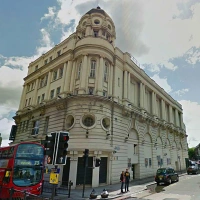

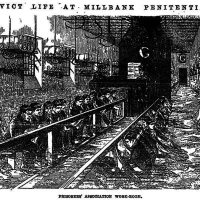
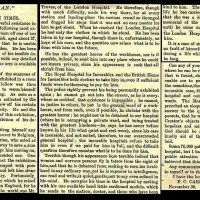


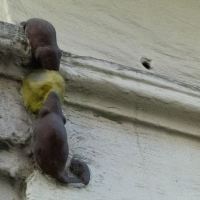
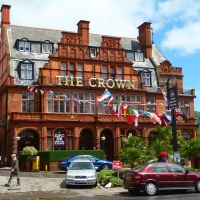

We go to St Pancras a lot as it’s just down the road from us and many of our journeys start there. It’s about my favourite station and I am familiar with most of the features you mention (the high-cost ones excepted!). I didn’t know the story of the clock and find it fascinating – I hope they refunded Roland Hoggard’s £25!
I have ambivalent feelings about Paul Day’s embracing couple (not very good, in my opinion) but the frieze is marvelous. I see something new in it nearly every time I look at it. It’s heartening too, to see how many people stop to photograph dear old John Betjeman or have their photo taken with him. It’s good too to see people going out into the courtyard to photograph it or just stand and take in the scene. It is a most wonderful building.
What strikes me when I look at the detail of the refurbishment of the station is the high quality of the work: just look at the beautifully finished woodwork of the doors, for example, and the metal fittings. There is no hint of penny-pinching.
[…] Please click here for Part Two […]
Until 1976, it was possible to catch an Inter City train to Glasgow from St Pancras, which called at all the major stations in the East Midlands, before going via Sheffield, Leeds and Carlisle to reach Glasgow. Rather a slow journey, but blessed with some spectacular scenery on the Settle to Carlisle branch and then over Beattock, and it was useful to places like Skipton by providing them with a link with London.
I loved reading your piece about my old workplace. I was a Plant and Machinery fitter based at St. Pancras from 1990 to 1999 and loved the place. Our department’s role in the building was to maintain all of the electrical and mechanical services inside the station, the lighting, LV power supplies, the original hydraulic buffer stops, air conditioning and lifts. I pretty much knew every nook and cranny of the old station and spent many an hour wandering around the old undercroft and it’s warren of workshops and corridors.
The main reason I stopped to comment was that you have one of the few pictures of one of the roof rigs. There were 3 rigs, East, Central and West, your picture with the 45s show the central rig at the south end of the roof, it’s only really visible if you know what you are looking for. The three rigs were installed so that the civils teams could carry out maintenance and inspection of the inside of the train shed without the need to build scaffolds which would have taken forever to build and would have never come down. I used to maintain these machines and was an operator for the teams who needed to inspect the roof and when there was a lighting renewal at the station in the later half of the 90s. I wished i’d had a camera to take some pics at the time but obviously never did. I does make me chuckle that the lovely straight RSJs which run along the inside of the shed were what the rigs trundled along because to look at them you’d think they were part of the original construction. I do wonder how the roof will be inspected in future since they removed them for the International station.
Thanks for the memories.
Dave G